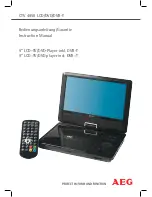
TEST PROCEDURE FOR NORMAL
CONTROL BOARD OPERATION
1. Remove main supply power to the DC-1500.
2. Remove screws, loosen and lower the top left
case side panel to access and inspect the
Control Board located in the upper control box
of the welder.
3. Apply the correct three-phase input power to
the DC-1500. Turn on the machine.
4. Connect a jumper wire from terminal #2 to ter-
minal #4 on the terminal strip. These can be
accessed through the front panel assembly
door.
5. LED 1 should be lit indicating the presence of
115 VAC at leads #255 to #256 of 12 Pin Molex
Plug. See Figure F.10.
6. LED 3 should be lit indicating power is being
applied to the fault protection relay (2CR).
7. LED 4 should NOT be lit. LED 4 should light
only if there is a “fault” condition.
8. LED 2 should be lit indicating output voltage
feedback is being supplied to the Control
Board. With the Output Control Switch (SW4)
in the “Output Control At DC-1500” (Panel)
position and the Welding Mode Switch (SW5)
in a CV position, LED 2 should change in
brightness
as
the
Output
Control
Potentiometer is rotated. As the open circuit
voltage is increased, LED 2 should get brighter
and vice versa.
9. LED 5 indicates a control signal (lead #231) is
being supplied to the firing circuit. As the out-
put is varied, LED 5 should change in brillian-
cy from bright (at low output) to dim (at high
output). When the Weld Mode Switch (SW5) is
in the CC (Stick) position, the open circuit volt-
age is at maximum, and LED 5 will be very dim
or not lit.
L7
L8
L9
L1
L3
L5
L6
L4
L2
12 PIN
9 PIN
G1587-1
L7
L8
L9
L1
L3
L5
L6
L4
L2
12 PIN
9 PIN
G1587-1
FIGURE F.10 – JUMPER
CONTROL BOARD TEST PROCEDURE (continued)
TROUBLESHOOTING AND REPAIR
F-32
F-32
IDEALARC® DC-1500
JUMPERING LEADS 2 AND 4 ELECTRICALLY
ENERGIZES MACHINE’S OUTPUT TERMI-
NALS. DO NOT TOUCH ELECTRICALLY HOT
COMPONENTS.
--------------------------------------------------------------------------------
WARNING
















































